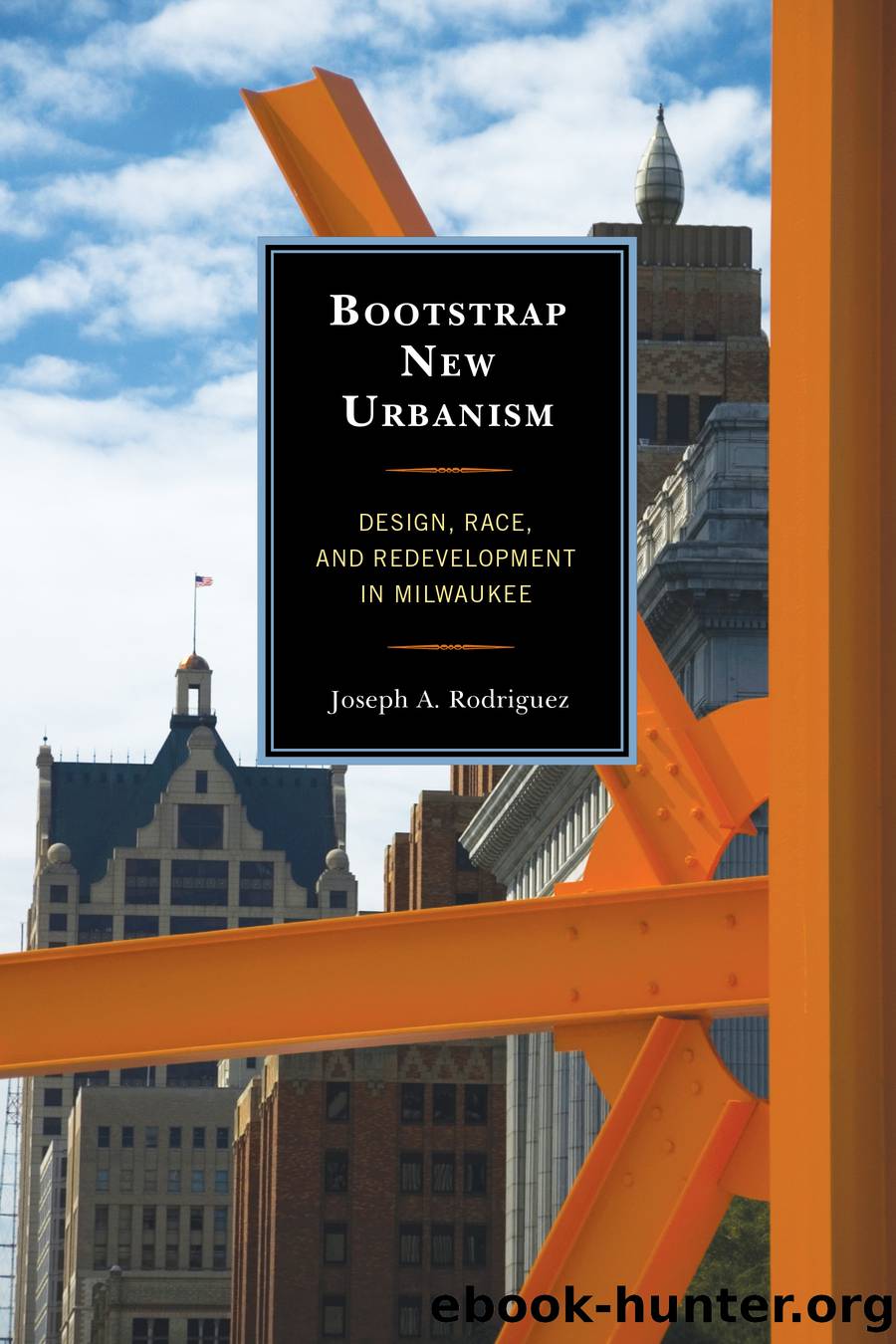Bootstrap New Urbanism by Rodriguez Joseph A.;

Author:Rodriguez, Joseph A.;
Language: eng
Format: epub
Tags: undefined
Publisher: Lexington Books/Fortress Academic
Published: 2012-08-15T00:00:00+00:00
The color photographs in âNo RSVP Neededâ dominated the page as the text was minimalâusually nothing more than expanded captions. The color photographs depicted men and women socializing in various clubs in and around Milwaukee. The photographs included first and last names of the patrons. The text gave details about each club (drinks available, other activities, type of crowd in attendance). The photographs were mostly âcrowd shotsâ but included posed and un-posed pictures of patrons.[51] Because they depict groups and couples interacting, the photographs are a visual representation of community-centeredness that New Urbanist planners claimed their designs facilitated.
âNo RSVP Requiredâ was free advertising for the establishments as well as free advertisements for the alcohol (brand names are frequently given and bottle labels are highlighted) that can be purchased at the venue. In the nineteenth century, U.S. newspaper advertisements only showed the image of the product. By the early twentieth century, advertising progressed to âshowing the product in use,â which was deemed more convincing.[52] This is precisely what the photographs in âNo RSVP Neededâ did more effectively than âadvertisementsâ because the users of the products were ârealâ people who ostensibly made their choice of products to consume and where to consume them free of any outside influence. They are âcaught in the actâ rather than models posing with a product.
Alcohol advertising is associated with colored images that appear on the television and magazines printed on glossy paper. One of the most famous advertising campaigns, images of the bottle of âAbsolutâ vodka, appeared in glossy magazines that highlighted artistic renderings of the bottleâs shape made of different materials. However, with new printing technologies, newspapers now match the clarity of magazines. The clarity of color photographs in âNo RSVP Neededâ advertises the newspaper as a viable competitor to glossy magazine advertising.
In essence, these photographs approximated tourism advertisements. They encouraged readers to view themselves as an urban tourist and the cityâs bars become tourist sites in the sense that the images explored venues worth visiting. Thus, these photographs amounted to patrons performing for the photojournalist and creating âplace mythsâ that represented the type of bar (working class, upscale dance club, etc.) and the type of people (age, profession) who patronize or work at the bar.[53] Readers viewed the photographs as accurate presentations of the barsâ ambiance and type of patrons since these are supposedly not actors but actual customers.
In the late twentieth century, imagery again became central to urban promotion. As cities competed for residents and businesses they ratcheted up their visual production. Photography and video are the preferred methods of selling the city today. Photographs of the city were part of elaborate advertising campaigns.[54] Computers and Geographical Information Systems (GIS) make visual representations quick and cheap to produce and reproduce. Cities increasingly compete to produce positive visual information. The MJS noted that Milwaukee had to compete with places like Atlanta that were further ahead in producing visual geographic information to help companies find land and buildings available for development.[55]
Similarly, urban officials use advertisements with catch phrases and mottos to encapsulate the cityâs cultural and economic vitality.
Download
This site does not store any files on its server. We only index and link to content provided by other sites. Please contact the content providers to delete copyright contents if any and email us, we'll remove relevant links or contents immediately.
| Africa | Americas |
| Arctic & Antarctica | Asia |
| Australia & Oceania | Europe |
| Middle East | Russia |
| United States | World |
| Ancient Civilizations | Military |
| Historical Study & Educational Resources |
Cat's cradle by Kurt Vonnegut(14760)
Pimp by Iceberg Slim(13779)
Underground: A Human History of the Worlds Beneath Our Feet by Will Hunt(11839)
4 3 2 1: A Novel by Paul Auster(11792)
The Radium Girls by Kate Moore(11621)
Wiseguy by Nicholas Pileggi(5319)
American History Stories, Volume III (Yesterday's Classics) by Pratt Mara L(5136)
Perfect Rhythm by Jae(5072)
The Fire Next Time by James Baldwin(5017)
Paper Towns by Green John(4800)
Pale Blue Dot by Carl Sagan(4618)
A Higher Loyalty: Truth, Lies, and Leadership by James Comey(4552)
The Mayflower and the Pilgrims' New World by Nathaniel Philbrick(4281)
The Doomsday Machine by Daniel Ellsberg(4246)
Killers of the Flower Moon: The Osage Murders and the Birth of the FBI by David Grann(4189)
Too Much and Not the Mood by Durga Chew-Bose(4095)
The Sympathizer by Viet Thanh Nguyen(4095)
The Borden Murders by Sarah Miller(4019)
Sticky Fingers by Joe Hagan(3912)
